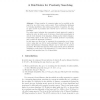Free Online Productivity Tools
i2Speak
i2Symbol
i2OCR
iTex2Img
iWeb2Print
iWeb2Shot
i2Type
iPdf2Split
iPdf2Merge
i2Bopomofo
i2Arabic
i2Style
i2Image
i2PDF
iLatex2Rtf
Sci2ools
CIARP
2009
Springer
2009
Springer
A Brief Index for Proximity Searching
A large number of computer tasks can be modeled as the search for an object near a given query. From multimedia databases to learning algorithms, data mining and pattern recognition, the metric space model of proximity and retrieval can be used as a searching paradigm. For metric space indexing the permutation based approach consist in saving the order in which a set of reference objects (the permutants) is seen by every element of the database. Adding up the relative displacements with respect to the query is an excellent predictor of proximity, and is called the Spearman ρ distance. In this paper we show how to represent the permutation as a binary vector, using just one bit for each permutant (instead of log k in the plain representation). Hamming distance can be used then to predict proximity. We tested this approach with many real life metric databases obtaining a recall close to the Spearman ρ (or even better in some examples), and speedup from 2 to 4 times faster.
| Added | 02 Sep 2010 |
| Updated | 02 Sep 2010 |
| Type | Conference |
| Year | 2009 |
| Where | CIARP |
| Authors | Eric Sadit Tellez, Edgar Chávez, Antonio Camarena-Ibarrola |
Comments (0)

